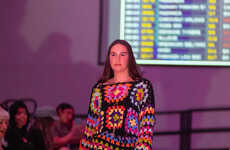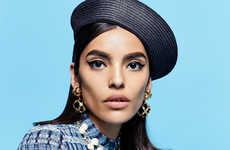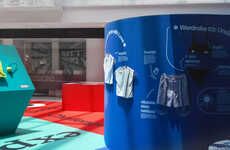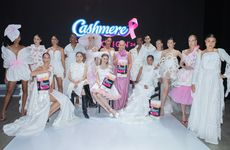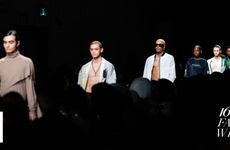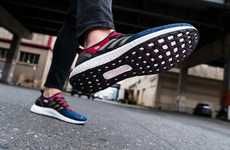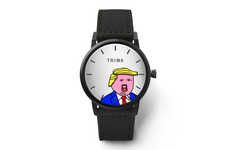
A Conversation with Canadian Fashion Designer Hilary Macmillan
Jana Pijak — September 6, 2019 — Business
References: hilarymacmillan
Canadian fashion designer Hilary Macmillan is the face behind her self-titled brand which prides itself on creating contemporary, size-inclusive and cruelty-free pieces that are also offered at an accessible price point.
Tell us about yourself and how this collection differs from your previous work?
We are a Canadian contemporary cruelty-free womenswear brand and we design for the modern woman who needs pieces in her life that are transitional, but also on point with seasonal trends. Every collection is built off the last and a progression from the previous season.
Tell us about your creative process and how you reset when experiencing creative roadblocks?
My creative process morphs over the lifespan of developing a collection and very much changes and shifts based on fabric, silhouettes, colors, etc. It is continually being expanded and then edited down throughout a season. When I encounter a roadblock creatively, I find the best way to reset is to immerse myself in art and fashion. I visit exhibits, go to art galleries, watch documentaries, and try and discover new techniques.
How do you set yourself apart from others on the Toronto Fashion Week runway stage?
My aim isn’t to set myself apart from other designers at Toronto Fashion week, it really is to stick to our brand ethos and try and develop the best product for us. Every collection shown at TFW is unique in its' own right and that is the beauty of the event: you get to see everything from bridal to menswear to outerwear.
As someone who has had success within a competitive industry for some time now, what is your advice for young designers?
My advice always is to go work for someone first who is in the same realm of what you want to design. If you wanted to do tailored menswear go work with a menswear company. The experience and connections you’ll gain while working there is invaluable.
We're huge fans of your female-empowering brand and were wondering if you can speak more about inclusivity within the Canadian fashion industry.
In my ideal world, everything would be inclusive across all spectrums and I definitely think the conversation is there and it is starting to shift. I am very proud that we are in a position now where we can be more size-inclusive because I think it is important. Everything we do depends on if there is a demand for it. So I encourage people to really speak/vote/express your opinion with your dollar. If supporting Canadian brands is important to you buy more Canadian. If you want to see more businesses be size-inclusive, then support those businesses that are because this is how we make change.
What's the biggest game-changing trend you've seen that's impacting your industry today?
The power of social media, and really the internet. Even 4-5 years ago it was much harder to directly communicate with your customers and now with social media, you have a platform and an ability to shoot your message out to as many people as you want. The use of social media totally changes how we do our marketing and where to put certain campaigns, and the data and metrics we can obtain is invaluable. You learn where your products sell well, what age range, what their interests are, etc. It really helps figure out who your ideal customer is.
How often do you draw inspiration outside of your own industry?
All the time. Fashion is so connected to all aspects of our lives.
Where do you see Toronto's fashion industry in 5 years?
Bigger! I think people are starting to listen to our voice a bit more, and we are becoming world players more and more.
Image Credit: Ted Belton
Tell us about yourself and how this collection differs from your previous work?
We are a Canadian contemporary cruelty-free womenswear brand and we design for the modern woman who needs pieces in her life that are transitional, but also on point with seasonal trends. Every collection is built off the last and a progression from the previous season.
Tell us about your creative process and how you reset when experiencing creative roadblocks?
My creative process morphs over the lifespan of developing a collection and very much changes and shifts based on fabric, silhouettes, colors, etc. It is continually being expanded and then edited down throughout a season. When I encounter a roadblock creatively, I find the best way to reset is to immerse myself in art and fashion. I visit exhibits, go to art galleries, watch documentaries, and try and discover new techniques.
How do you set yourself apart from others on the Toronto Fashion Week runway stage?
My aim isn’t to set myself apart from other designers at Toronto Fashion week, it really is to stick to our brand ethos and try and develop the best product for us. Every collection shown at TFW is unique in its' own right and that is the beauty of the event: you get to see everything from bridal to menswear to outerwear.
As someone who has had success within a competitive industry for some time now, what is your advice for young designers?
My advice always is to go work for someone first who is in the same realm of what you want to design. If you wanted to do tailored menswear go work with a menswear company. The experience and connections you’ll gain while working there is invaluable.
We're huge fans of your female-empowering brand and were wondering if you can speak more about inclusivity within the Canadian fashion industry.
In my ideal world, everything would be inclusive across all spectrums and I definitely think the conversation is there and it is starting to shift. I am very proud that we are in a position now where we can be more size-inclusive because I think it is important. Everything we do depends on if there is a demand for it. So I encourage people to really speak/vote/express your opinion with your dollar. If supporting Canadian brands is important to you buy more Canadian. If you want to see more businesses be size-inclusive, then support those businesses that are because this is how we make change.
What's the biggest game-changing trend you've seen that's impacting your industry today?
The power of social media, and really the internet. Even 4-5 years ago it was much harder to directly communicate with your customers and now with social media, you have a platform and an ability to shoot your message out to as many people as you want. The use of social media totally changes how we do our marketing and where to put certain campaigns, and the data and metrics we can obtain is invaluable. You learn where your products sell well, what age range, what their interests are, etc. It really helps figure out who your ideal customer is.
How often do you draw inspiration outside of your own industry?
All the time. Fashion is so connected to all aspects of our lives.
Where do you see Toronto's fashion industry in 5 years?
Bigger! I think people are starting to listen to our voice a bit more, and we are becoming world players more and more.
Image Credit: Ted Belton
Trend Themes
1. Size-inclusive Fashion - An opportunity for fashion brands to expand their target market and offer more inclusive clothing options.
2. Cruelty-free Clothing - An opportunity for clothing brands to address consumer preferences for sustainable and ethical fashion production.
3. Social Media Marketing - An opportunity for fashion brands to reach a wider audience and gather valuable customer data through effective social media strategies.
Industry Implications
1. Fashion Industry - The fashion industry can seize opportunities to innovate and create more sustainable, size-inclusive and cruelty-free products.
2. Marketing Industry - The marketing industry can capitalize on the use of social media and data analytics to develop effective marketing and influencer strategies for fashion brands.
3. Retail Industry - The retail industry can expand their offerings to cater to the growing demand for size-inclusive and sustainable fashion options.
4.9
Score
Popularity
Activity
Freshness


